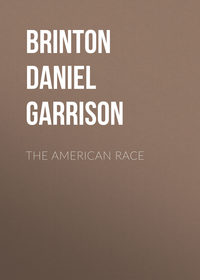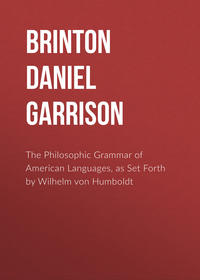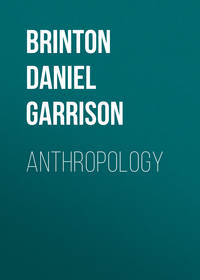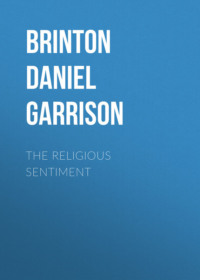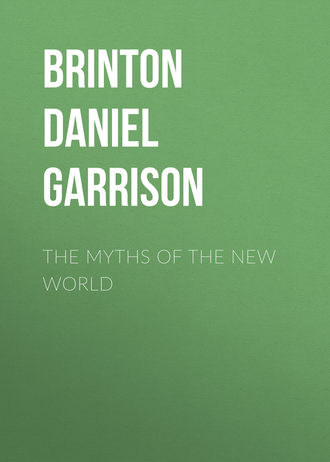 полная версия
полная версияThe Myths of the New World
The myth of the Quichés but changes the name of this pleasant land. With them it was Pan-paxil-pa-cayala, where the waters divide in falling, or between the waters parcelled out and mucky. This was “an excellent land, full of pleasant things, where was store of white corn and yellow corn, where one could not count the fruits, nor estimate the quantity of honey and food.” Over it ruled the lord of the air, and from it the four sacred animals carried the corn to make the flesh of men.109
Once again, in the legends of the Mixtecas, we hear the old story repeated of the garden where the first two brothers dwelt. It lay between a meadow and that lofty peak which supports the heavens and the palaces of the gods. “Many trees were there, such as yield flowers and roses, very luscious fruits, divers herbs, and aromatic spices.” The names of the brothers were the Wind of Nine Serpents and the Wind of Nine Caverns. The first was as an eagle, and flew aloft over the waters that poured around their enchanted garden; the second was as a serpent with wings, who proceeded with such velocity that he pierced rocks and walls. They were too swift to be seen by the sharpest eye, and were one near as they passed, he was only aware of a whisper and a rustling like that of the wind in the leaves.110
Wherever, in short, the lust of gold lured the early adventurers, they were told of some nation a little further on, some wealthy and prosperous land, abundant and fertile, satisfying the desire of the heart. It was sometimes deceit, and it was sometimes the credited fiction of the earthly paradise, that in all ages has with a promise of perfect joy consoled the aching heart of man.
It is instructive to study the associations that naturally group themselves around each of the cardinal points, and watch how these are mirrored on the surface of language, and have directed the current of thought. Jacob Grimm has performed this task with fidelity and beauty as regards the Aryan race, but the means are wanting to apply his searching method to the indigenous tongues of America. Enough if in general terms their mythological value be determined.
When the day begins, man wakes from his slumbers, faces the rising sun, and prays. The east is before him; by it he learns all other directions; it is to him what the north is to the needle; with reference to it he assigns in his mind the position of the three other cardinal points.111 There is the starting place of the celestial fires, the home of the sun, the womb of the morning. It represents in space the beginning of things in time, and as the bright and glorious creatures of the sky come forth thence, man conceits that his ancestors also in remote ages wandered from the orient; there in the opinion of many in both the old and new world was the cradle of the race; there in Aztec legend was the fabled land of Tlapallan, and the wind from the east was called the wind of Paradise, Tlalocavitl.
From this direction came, according to the almost unanimous opinion of the Indian tribes, those hero gods who taught them arts and religion, thither they returned, and from thence they would again appear to resume their ancient sway. As the dawn brings light, and with light is associated in every human mind the ideas of knowledge, safety, protection, majesty, divinity, as it dispels the spectres of night, as it defines the cardinal points, and brings forth the sun and the day, it occupied the primitive mind to an extent that can hardly be magnified beyond the truth. It is in fact the central figure in most natural religions.
The west, as the grave of the heavenly luminaries, or rather as their goal and place of repose, brings with it thoughts of sleep, of death, of tranquillity, of rest from labor. When the evening of his days was come, when his course was run, and man had sunk from sight, he was supposed to follow the sun and find some spot of repose for his tired soul in the distant west. There, with general consent, the tribes north of the Gulf of Mexico supposed the happy hunting grounds; there, taught by the same analogy, the ancient Aryans placed the Nerriti, the exodus, the land of the dead. “The old notion among us,” said on one occasion a distinguished chief of the Creek nation, “is that when we die, the spirit goes the way the sun goes, to the west, and there joins its family and friends who went before it.”112
In the northern hemisphere the shadows fall to the north, thence blow cold and furious winds, thence come the snow and early thunder. Perhaps all its primitive inhabitants, of whatever race, thought it the seat of the mighty gods.113 A floe of ice in the Arctic Sea was the home of the guardian spirit of the Algonkins;114 on a mountain near the north star the Dakotas thought Heyoka dwelt who rules the seasons; and the realm of Mictla, the Aztec god of death, lay where the shadows pointed. From that cheerless abode his sceptre reached over all creatures, even the gods themselves, for sooner or later all must fall before him. The great spirit of the dead, said the Ottawas, lives in the dark north,115 and there, in the opinion of the Monquis of California, resided their chief god, Gumongo.116
Unfortunately the makers of vocabularies have rarely included the words north, south, east, and west, in their lists, and the methods of expressing these ideas adopted by the Indians can only be partially discovered. The east and west were usually called from the rising and setting of the sun as in our words orient and occident, but occasionally from traditional notions. The Mayas named the west the greater, the east the lesser debarkation; believing that while their culture hero Zamna came from the east with a few attendants, the mass of the population arrived from the opposite direction.117 The Aztecs spoke of the east as “the direction of Tlalocan,” the terrestrial paradise. But for north and south there were no such natural appellations, and consequently the greatest diversity is exhibited in the plans adopted to express them. The north in the Caddo tongue is “the place of cold,” in Dakota “the situation of the pines,” in Creek “the abode of the (north) star,” in Algonkin “the home of the soul,” in Aztec “the direction of Mictla” the realm of death, in Quiché and Quichua, “to the right hand;”118 while for the south we find such terms as in Dakota “the downward direction,” in Algonkin “the place of warmth,” in Quiché “to the left hand,” while among the Eskimos, who look in this direction for the sun, its name implies “before one,” just as does the Hebrew word kedem, which, however, this more southern tribe applied to the east.
We can trace the sacredness of the number four in other curious and unlooked-for developments. Multiplied into the number of the fingers—the arithmetic of every child and ignorant man—or by adding together the first four members of its arithmetical series (4 + 8 + 12 + 16), it gives the number forty. This was taken as a limit to the sacred dances of some Indian tribes, and by others as the highest number of chants to be employed in exorcising diseases. Consequently it came to be fixed as a limit in exercises of preparation or purification. The females of the Orinoko tribes fasted forty days before marriage, and those of the upper Mississippi were held unclean the same length of time after childbirth; such was the term of the Prince of Tezcuco’s fast when he wished an heir to his throne, and such the number of days the Mandans supposed it required to wash clean the world at the deluge.119
No one is ignorant how widely this belief was prevalent in the old world, nor how the quadrigesimal is still a sacred term with some denominations of Christianity. But a more striking parallelism awaits us. The symbol that beyond all others has fascinated the human mind, THE CROSS, finds here its source and meaning. Scholars have pointed out its sacredness in many natural religions, and have reverently accepted it as a mystery, or offered scores of conflicting and often debasing interpretations. It is but another symbol of the four cardinal points, the four winds of heaven. This will luminously appear by a study of its use and meaning in America.
The Catholic missionaries found it was no new object of adoration to the red race, and were in doubt whether to ascribe the fact to the pious labors of Saint Thomas or the sacrilegious subtlety of Satan. It was the central object in the great temple of Cozumel, and is still preserved on the bas-reliefs of the ruined city of Palenque. From time immemorial it had received the prayers and sacrifices of the Aztecs and Toltecs, and was suspended as an august emblem from the walls of temples in Popoyan and Cundinamarca. In the Mexican tongue it bore the significant and worthy name “Tree of Our Life,” or “Tree of our Flesh” (Tonacaquahuitl). It represented the god of rains and of health, and this was everywhere its simple meaning. “Those of Yucatan,” say the chroniclers, “prayed to the cross as the god of rains when they needed water.” The Aztec goddess of rains bore one in her hand, and at the feast celebrated to her honor in the early spring victims were nailed to a cross and shot with arrows. Quetzalcoatl, god of the winds, bore as his sign of office “a mace like the cross of a bishop;” his robe was covered with them strown like flowers, and its adoration was throughout connected with his worship.120 When the Muyscas would sacrifice to the goddess of waters they extended cords across the tranquil depths of some lake, thus forming a gigantic cross, and at their point of intersection threw in their offerings of gold, emeralds, and precious oils.121 The arms of the cross were designed to point to the cardinal points and represent the four winds, the rain bringers. To confirm this explanation, let us have recourse to the simpler ceremonies of the less cultivated tribes, and see the transparent meaning of the symbol as they employed it.
When the rain maker of the Lenni Lenape would exert his power, he retired to some secluded spot and drew upon the earth the figure of a cross (its arms toward the cardinal points?), placed upon it a piece of tobacco, a gourd, a bit of some red stuff, and commenced to cry aloud to the spirits of the rains.122 The Creeks at the festival of the Busk, celebrated, as we have seen, to the four winds, and according to their legends instituted by them, commenced with making the new fire. The manner of this was “to place four logs in the centre of the square, end to end, forming a cross, the outer ends pointing to the cardinal points; in the centre of the cross the new fire is made.”123
As the emblem of the winds who dispense the fertilizing showers it is emphatically the tree of our life, our subsistence, and our health. It never had any other meaning in America, and if, as has been said,124 the tombs of the Mexicans were cruciform, it was perhaps with reference to a resurrection and a future life as portrayed under this symbol, indicating that the buried body would rise by the action of the four spirits of the world, as the buried seed takes on a new existence when watered by the vernal showers. It frequently recurs in the ancient Egyptian writings, where it is interpreted life; doubtless, could we trace the hieroglyph to its source, it would likewise prove to be derived from the four winds.
While thus recognizing the natural origin of this consecrated symbol, while discovering that it is based on the sacredness of numbers, and this in turn on the structure and necessary relations of the human body, thus disowning the meaningless mysticism that Joseph de Maistre and his disciples have advocated, let us on the other hand be equally on our guard against accepting the material facts which underlie these beliefs as their deepest foundation and their exhaustive explanation. That were but withered fruit for our labors, and it might well be asked, where is here the divine idea said to be dimly prefigured in mythology? The universal belief in the sacredness of numbers is an instinctive faith in an immortal truth; it is a direct perception of the soul, akin to that which recognizes a God. The laws of chemical combination, of the various modes of motion, of all organic growth, show that simple numerical relations govern all the properties and are inherent to the very constitution of matter; more marvellous still, the most recent and severe inductions of physicists show that precisely those two numbers on whose symbolical value much of the edifice of ancient mythology was erected, the four and the three, regulate the molecular distribution of matter and preside over the symmetrical development of organic forms. This asks no faith, but only knowledge; it is science, not revelation. In view of such facts is it presumptuous to predict that experiment itself will prove the truth of Kepler’s beautiful saying: “The universe is a harmonious whole, the soul of which is God; numbers, figures, the stars, all nature, indeed, are in unison with the mysteries of religion”?
CHAPTER IV.
THE SYMBOLS OF THE BIRD AND THE SERPENT
Relations of man to the lower animals.—Two of these, the Bird and the Serpent, chosen as symbols beyond all others.—The Bird throughout America the symbol of the Clouds and Winds.—Meaning of certain species.—The symbolic meaning of the Serpent derived from its mode of locomotion, its poisonous bite, and its power of charming.—Usually the symbol of the Lightning and the Waters.—The Rattlesnake the symbolic species in America.—The war charm.—The Cross of Palenque.—The god of riches.—Both symbols devoid of moral significance.
THOSE stories which the Germans call Thierfabeln, wherein the actors are different kinds of brutes, seem to have a particular relish for children and uncultivated nations. Who cannot recall with what delight he nourished his childish fancy on the pranks of Reynard the Fox, or the tragic adventures of Little Red Riding Hood and the Wolf? Every nation has a congeries of such tales, and it is curious to mark how the same animal reappears with the same imputed physiognomy in all of them. The fox is always cunning, the wolf ravenous, the owl wise, and the ass foolish. The question has been raised whether such traits were at first actually ascribed to animals, or whether their introduction in story was intended merely as an agreeable figure of speech for classes of men. We cannot doubt but that the former was the case. Going back to the dawn of civilization, we find these relations not as amusing fictions, but as myths, embodying religious tenets, and the brute heroes held up as the ancestors of mankind, even as rightful claimants of man’s prayers and praises.
Man, the paragon of animals, praying to the beast, is a spectacle so humiliating that, for the sake of our common humanity, we may seek the explanation of it least degrading to the dignity of our race. We must remember that as a hunter the primitive man was always matched against the wild creatures of the woods, so superior to him in their dumb certainty of instinct, their swift motion, their muscular force, their permanent and sufficient clothing. Their ways were guided by a wit beyond his divination, and they gained a living with little toil or trouble. They did not mind the darkness so terrible to him, but through the night called one to the other in a tongue whose meaning he could not fathom, but which, he doubted not, was as full of purport as his own. He did not recognize in himself those god-like qualities destined to endow him with the royalty of the world, while far more clearly than we do he saw the sly and strange faculties of his antagonists. They were to him, therefore, not inferiors, but equals—even superiors. He doubted not that once upon a time he had possessed their instinct, they his language, but that some necromantic spell had been flung on them both to keep them asunder. None but a potent sorcerer could break this charm, but such an one could understand the chants of birds and the howls of savage beasts, and on occasion transform himself into one or another animal, and course the forest, the air, or the waters, as he saw fit. Therefore, it was not the beast that he worshipped, but that share of the omnipresent deity which he thought he perceived under its form.125
Beyond all others, two subdivisions of the animal kingdom have so riveted the attention of men by their unusual powers, and enter so frequently into the myths of every nation of the globe, that a right understanding of their symbolic value is an essential preliminary to the discussion of the divine legends. They are the Bird and the Serpent. We shall not go amiss if we seek the reasons of their pre-eminence in the facility with which their peculiarities offered sensuous images under which to convey the idea of divinity, ever present in the soul of man, ever striving at articulate expression.
The bird has the incomprehensible power of flight; it floats in the atmosphere, it rides on the winds, it soars toward heaven where dwell the gods; its plumage is stained with the hues of the rainbow and the sunset; its song was man’s first hint of music; it spurns the clods that impede his footsteps, and flies proudly over the mountains and moors where he toils wearily along. He sees no more enviable creature; he conceives the gods and angels must also have wings; and pleases himself with the fancy that he, too, some day will shake off this coil of clay, and rise on pinions to the heavenly mansions. All living beings, say the Eskimos, have the faculty of soul (tarrak), but especially the birds.126 As messengers from the upper world and interpreters of its decrees, the flight and the note of birds have ever been anxiously observed as omens of grave import. “There is one bird especially,” remarks the traveller Coreal, of the natives of Brazil, “which they regard as of good augury. Its mournful chant is heard rather by night than day. The savages say it is sent by their deceased friends to bring them news from the other world, and to encourage them against their enemies.”127 In Peru and in Mexico there was a College of Augurs, corresponding in purpose to the auspices of ancient Rome, who practised no other means of divination than watching the course and professing to interpret the songs of fowls. So natural and so general is such a superstition, and so wide-spread is the respect it still obtains in civilized and Christian lands, that it is not worth while to summon witnesses to show that it prevailed universally among the red race also. What imprinted it with redoubled force on their imagination was the common belief that birds were not only divine nuncios, but the visible spirits of their departed friends. The Powhatans held that a certain small wood bird received the souls of their princes at death, and they refrained religiously from doing it harm;128 while the Aztecs and various other nations thought that all good people, as a reward of merit, were metamorphosed at the close of life into feathered songsters of the grove, and in this form passed a certain term in the umbrageous bowers of Paradise.
But the usual meaning of the bird as a symbol looks to a different analogy—to that which appears in such familiar expressions as “the wings of the wind,” “the flying clouds.” Like the wind, the bird sweeps through the aerial spaces, sings in the forests, and rustles on its course; like the cloud, it floats in mid-air and casts its shadow on the earth; like the lightning, it darts from heaven to earth to strike its unsuspecting prey. These tropes were truths to savage nations, and led on by that law of language which forced them to conceive everything as animate or inanimate, itself the product of a deeper law of thought which urges us to ascribe life to whatever has motion, they found no animal so appropriate for their purpose here as the bird. Therefore the Algonkins say that birds always make the winds, that they create the water spouts, and that the clouds are the spreading and agitation of their wings;129 the Navajos, that at each cardinal point stands a white swan, who is the spirit of the blasts which blow from its dwelling; and the Dakotas, that in the west is the house of the Wakinyan, the Flyers, the breezes that send the storms. So, also, they frequently explain the thunder as the sound of the cloud-bird flapping his wings, and the lightning as the fire that flashes from his tracks, like the sparks which the buffalo scatters when he scours over a stony plain.130 The thunder cloud was also a bird to the Caribs, and they imagined it produced the lightning in true Carib fashion by blowing it through a hollow reed, just as they to this day hurl their poisoned darts.131 Tupis, Iroquois, Athapascas, for certain, perhaps all the families of the red race, were the subject pursued, partook of this persuasion; among them all it would probably be found that the same figures of speech were used in comparing clouds and winds with the feathered species as among us, with however this most significant difference, that whereas among us they are figures and nothing more, to them they expressed literal facts.
How important a symbol did they thus become! For the winds, the clouds, producing the thunder and the changes that take place in the ever-shifting panorama of the sky, the rain bringers, lords of the seasons, and not this only, but the primary type of the soul, the life, the breath of man and the world, these in their role in mythology are second to nothing. Therefore as the symbol of these august powers, as messenger of the gods, and as the embodiment of departed spirits, no one will be surprised if they find the bird figure most prominently in the myths of the red race.
Sometimes some particular species seems to have been chosen as most befitting these dignified attributes. No citizen of the United States will be apt to assert that their instinct led the indigenes of our territory astray when they chose with nigh unanimous consent the great American eagle as that fowl beyond all others proper to typify the supreme control and the most admirable qualities. Its feathers composed the war flag of the Creeks, and its images carved in wood or its stuffed skin surmounted their council lodges (Bartram); none but an approved warrior dare wear it among the Cherokees (Timberlake); and the Dakotas allowed such an honor only to him who had first touched the corpse of the common foe (De Smet). The Natchez and Akanzas seem to have paid it even religious honors, and to have installed it in their most sacred shrines (Sieur de Tonty, Du Pratz); and very clearly it was not so much for ornament as for a mark of dignity and a recognized sign of worth that its plumes were so highly prized. The natives of Zuñi, in New Mexico, employed four of its feathers to represent the four winds in their invocations for rain (Whipple), and probably it was the eagle which a tribe in Upper California (the Acagchemem) worshipped under the name Panes. Father Geronimo Boscana describes it as a species of vulture, and relates that one of them was immolated yearly, with solemn ceremony, in the temple of each village. Not a drop of blood was spilled, and the body burned. Yet with an amount of faith that staggered even the Romanist, the natives maintained and believed that it was the same individual bird they sacrificed each year; more than this, that the same bird was slain by each of the villages!132
The owl was regarded by Aztecs, Quichés, Mayas, Peruvians, Araucanians, and Algonkins as sacred to the lord of the dead. “The Owl” was one of the names of the Mexican Pluto, whose realm was in the north,133 and the wind from that quarter was supposed by the Chipeways to be made by the owl as the south by the butterfly.134 As the bird of night, it was the fit emissary of him who rules the darkness of the grave. Something in the looks of the creature as it sapiently stares and blinks in the light, or perhaps that it works while others sleep, got for it the character of wisdom. So the Creek priests carried with them as the badge of their learned profession the stuffed skin of one of these birds, thus modestly hinting their erudite turn of mind,135 and the culture hero of the Monquis of California was represented, like Pallas Athene, having one as his inseparable companion (Venegas).
As the associate of the god of light and air, and as the antithesis therefore of the owl, the Aztecs reverenced a bird called quetzal, which I believe is a species of parroquet. Its plumage is of a bright green hue, and was prized extravagantly as a decoration. It was one of the symbols and part of the name of Quetzalcoatl, their mythical civilizer, and the prince of all sorts of singing birds, myriads of whom were fabled to accompany him on his journeys.


